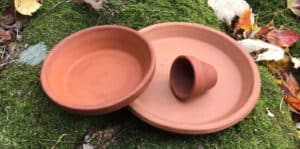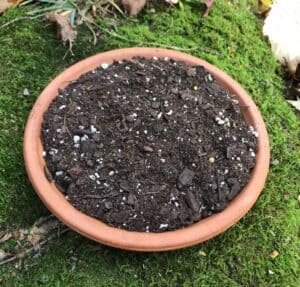This post contains affiliate links.
Succulent dish gardens are a creative way to display your succulent and cactus plants and are very easy to make, using just a few materials and your imagination.
They make excellent centerpieces for your dining room or coffee tables, brighten up the corners of your house or wherever you want to place them, and best of all, they are fun to make for either yourself or as a gift for a friend!
You only need a few supplies to make your dish garden or succulent bowl. There are some materials you need to gather, such as a shallow dish (or bowl), some succulent soil mix, and a selection of succulents such as Hens and Chicks or Stonecrops, but any shallow-rooted succulent should work.
We will guide you through the steps needed to create your own succulent dish garden using a terracotta dish as an example. Whether you use saucers, bowls, or another type of shallow dish is up to you; there are so many options that you can let your creativity be your guide. But first, I wanted to briefly talk about where these types of gardens got started.

Dish Gardens: A Brief History
While we don’t know exactly when the idea of dish gardens first came to be, there is an ancient Chinese art form called Penjing, where miniature scenes or landscapes are created using rocks, plants, and trees on shallow trays. (This is different from Bonsai.) This art form may be traced to around the year 100 AD, and the dish gardens of today could possibly be traced back to this ancient art.
But as I mentioned in our article on Succulent Teacups, there may be a more recent connection to the Victorian-era Terrariums of the 1800s, which went on to inspire open terrariums or dish gardens.
There is also another more recent art form called Saikei, which started as an offshoot of Bonsai in the mid 1900’s. This is the art of planting miniature gardens and landscapes in shallow trays, and they can include tiny figures of people, houses, and animals.
When I look at pictures of these older types of miniature gardens, I’m reminded of our more modern fairy gardens and decorative dish gardens that we see and enjoy today.
All of these—the art of Penjing, Saikei, Victorian-era terrariums, and the dish gardens that are so popular today—just prove to me that people at different times in history and places around the world all love the idea of miniature gardens as a way to bring beauty into their homes.
How to Make a Succulent Dish Garden
While we are using a terracotta saucer, in our example, there are many other possibilities available. When you make your succulent dish garden, you can experiment with a wide range of dishes or containers as well as different succulents you wish to use.
Step 1 Choose the Right Dish
Choose a shallow dish for your garden.
Consider the space available in your home and envision how your succulent garden will fit into that space.
I chose to use a smaller-sized terracotta saucer since I had extras on hand and liked the thought of a smaller arrangement in my home instead of a larger one.
I also chose this type of dish with the possibility in mind that I could add to this garden in the future, maybe even incorporating it into a fairy garden.
Terracotta dishes are ideal for what I had in mind since they come in different sizes, shapes, and depths, offering lots of possibilities for designing miniature dish gardens. You may even have some on hand that you can use for this purpose; if you don’t, then they are easily found at your local garden centers.
My local garden centers only have the standard sizes and not any of the more interesting styles but I have found a wider selection to choose from at Amazon, like these.
You are not limited to using terracotta dishes; there are many other types of shallow containers that you can use too. Just use your imagination!
How Deep Should a Succulent Dish Garden Be?
Containers for succulent dish gardens range from 2 inches to 6 inches in depth, although many recommend using no less than 3 inches in depth. This is somewhat debatable since Penjing and Saikei are forms of dish gardens, and their dishes (or trays) are often 2 inches or less in depth.
Succulents can tolerate these shallow dishes since their root systems are shallow. Just be sure to choose plants that tend to stay small, and make sure there will be adequate drainage and you should have no problems.
Step 2 Drainage Considerations
Succulents don’t like waterlogged soil, and that is why drainage is important.
Many containers already have drainage holes drilled into them, and that is great. If this is the case, then you are ready to go on to step 3.
But what if you have a dish or container that doesn’t have any drainage holes? In this case, you have two options:
- Make The Drainage Holes Yourself: You can learn how to drill drainage holes in the bottom of your dish or have someone do it for you. If you want to drill holes into the bottom of your container, then this video shows you one method.
- Treat Your Garden as an Open Terrarium:
With this method, you won’t need to drill drainage holes; instead, just plant and treat this garden as you would an open terrarium.
Open terrariums don’t use drainage holes but instead have a layer of pebbles and activated charcoal on the bottom for drainage. This layer allows the water to drain off of the soil and keeps it away from the roots. Obviously, this method works better with dishes that have several inches in depth for you to work with rather than a more shallow dish.
Step 3 Clean and Prepare Your Dishes
Before you start, clean your dishes to remove any residue that may be on them. Some residues may harm your plants, so it’s always best to start with a clean surface.

Step 4 Select Your Succulents
There are many species of succulents you can choose for your dish garden. Echeveria and Sedums are some types that you can use. You should choose types that tend to stay small or grow slowly.
I plan to use Hens and Chicks (Sempervivum tectorum), which is an Echeveria) and Sedum rupestre Angelina (a sedum or stonecrop), as well as some other succulents I have in my garden.
Mixing and matching colors add to your garden’s eye appeal, so try to choose succulents that look good together. You may also want to consider using some succulents that will creep or drape over the edge of the dish if you like that look.
Note: When you choose your succulents, be sure to pick ones that have the same or similar growth rates and watering needs.
Step 5 Choose the Arrangement You Want
Position your plants on the dish to visualize how the final garden will look. Make changes to the arrangement to help you choose what looks best, and once you have decided on your arrangement, it is time to plant.
Step 6 Add Soil And Plant
You will need to use succulent potting soil since succulents won’t do very well in regular potting soil.
You can buy bags of succulent soil locally or make it yourself, as shown here.
You can also find succulent soil mix on Amazon, like this mix here.

For a dish garden with drainage holes: Add a layer of succulent soil mix to the dish, leaving enough room for the plants. Add the plants as you have visualized in step 5, and add more soil around them as needed.
For a dish garden without drainage holes: Add enough pebbles or small gravel to cover the bottom of the dish (about 1-2 inches). Then add a thin layer of activated charcoal on top of the pebbles (about 1 inch). Finally, add about 2 inches of succulent soil mix, and then plant your succulents. Add more soil around the plants as needed.
Amazon has lots of different pebbles you can choose from, like these. Pebbles can also be used later on as a top dressing to give your garden a finished look.
Activated charcoal, such as this from Amazon, will help keep the garden clean from toxins that might build up over time.
Step 7 Add Decorative Elements
Adding pebbles or gravel as a top dressing will add to the visual appeal of your dish garden.

For a whimsical touch, you can add miniature accessories such as houses, figurines, ladders, and pathways to turn this into a fairy garden. For more information on making a Fairy garden, we’ve got an article right here that explains in detail how you can go about making one.
Furthermore, Amazon has a nice selection of Fairy Garden accessories that can also help you get a head start.
Step 8 Watering and Light
Once I get to this point, I like to water my plants. Succulents don’t like to be overwatered, so only water when the soil is dry. Moisture meter readers can help you gauge when the soil is completely dry. If you’d love to learn more about these moisture meter readers, then head on over to our other article that tells more.
Place your garden where it gets plenty of bright but indirect light. If you don’t have enough natural lighting in your home, then you should consider using a plant light to keep your succulents healthy.
This post was written for cactus-central.com and is not permitted to be used on other sites.
